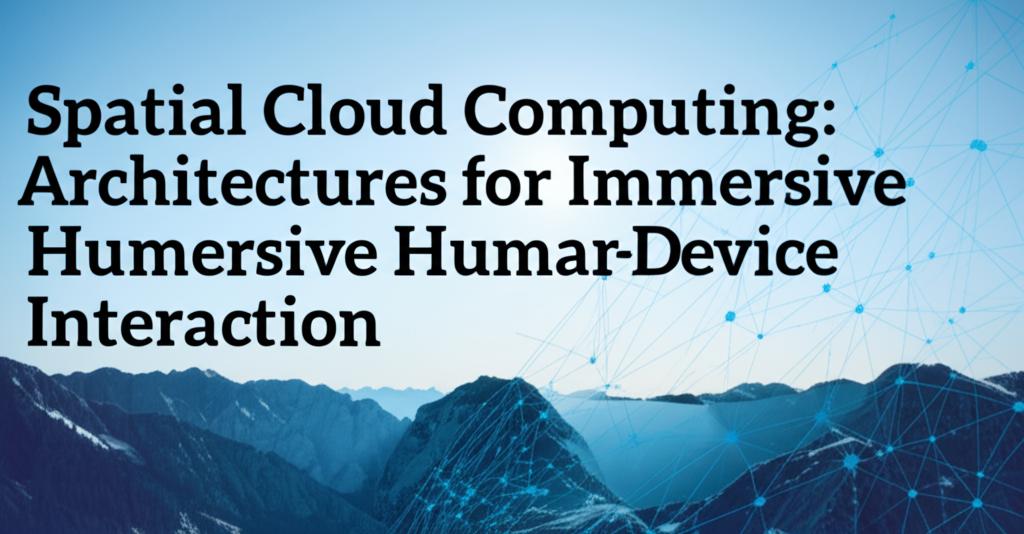Spatial cloud computing is rapidly transforming how we interact with digital information and the physical world, creating unprecedented opportunities for immersive experiences. This evolving field leverages a confluence of technologies including Augmented Reality (AR), Virtual Reality (VR), Mixed Reality (MR), 5G, AI, and the Internet of Things (IoT) to seamlessly blend digital content and real-world environments. The architectures underpinning these experiences are critical for delivering the necessary performance, scalability, and responsiveness.
At its core, spatial cloud computing offloads intensive processing and data storage from local devices (like VR headsets or AR glasses) to powerful cloud and edge servers. This approach addresses the high computational demands and battery life limitations inherent in current XR devices. Key architectural components often include:
- Client Layer: This encompasses the end-user devices (headsets, smartphones, tablets) responsible for capturing sensor data (location, orientation, environmental features), rendering immersive content, and handling user input. Lightweight clients are crucial for user comfort and mobility.
- Edge Computing Layer: Positioned closer to the user than centralized cloud servers, edge nodes play a vital role in reducing latency, which is critical for real-time immersive interactions. This layer can handle tasks like local data processing, content caching, and running AI algorithms for environment understanding and object recognition. The move towards distributed processing, leveraging both on-device capabilities and powerful edge cloud resources, is a key trend.
- Cloud Computing Layer: This layer provides robust and scalable resources for heavy computational tasks such as detailed 3D model rendering, complex simulations, large-scale data analytics, and persistent storage of spatial data and digital twins. Cloud platforms also facilitate collaboration and content sharing across multiple users and locations.
- Networking Fabric: High-bandwidth, low-latency networks, particularly 5G, are essential for connecting these layers seamlessly. Reliable and fast communication is paramount for streaming XR experiences from the cloud and ensuring real-time synchronization between the physical and virtual worlds.
- Distributed Processing: Architectures are increasingly moving towards a distributed model where processing tasks are intelligently allocated between the device, edge, and cloud based on factors like latency requirements, computational complexity, and data sensitivity.
- AI Integration: Artificial intelligence and machine learning are integral for enhancing spatial data processing, improving environment understanding, enabling more intuitive user interactions, and creating personalized, context-aware experiences. AI algorithms can run on the device, at the edge, or in the cloud.
- Digital Twins and 3D Modeling: The creation and maintenance of accurate, real-time digital representations of physical environments (digital twins) are fundamental. This involves advanced 3D reconstruction, semantic segmentation, and scene understanding, often powered by cloud services.
- Data Management and Security: Spatial computing generates and processes vast amounts of sensitive data about users and their environments. Architectures must incorporate robust data governance, privacy, and security measures.
- Scalability and Optimization: Platforms need to automatically scale resources to handle dynamic user loads and varying computational demands for diverse applications. Optimization techniques are crucial for minimizing delay and cost while maximizing performance.
- Interoperability and Standardization: As the spatial computing ecosystem grows, open standards and interoperable platforms (like OpenXR) will be crucial for enabling seamless experiences across different hardware and software.
- Event-Driven Architectures (EDA): EDA principles are being applied to create responsive, decoupled, and scalable spatial computing applications, particularly in complex, distributed environments.
These evolving architectures are paving the way for more natural and intuitive human-device interactions. By offloading processing, devices can become lighter and more comfortable, reducing user fatigue. Low-latency edge computing enables real-time feedback and seamless integration of virtual objects with the physical world, making interactions feel more realistic and responsive. AI-powered interfaces can understand natural language and gestures, simplifying complex tasks and making spatial computing accessible to a broader audience. The ability to create and interact with persistent digital twins of our surroundings opens up new possibilities for collaboration, training, design, and entertainment.
Challenges and the Future:Despite significant advancements, challenges remain. These include the high cost of infrastructure and development, data privacy and security concerns, and the need for more skilled developers. Network latency, while improved by 5G and edge computing, continues to be a critical factor. Furthermore, the lack of a single "killer app" to drive widespread consumer adoption is still a consideration.
The future of spatial cloud computing architectures will likely involve even tighter integration of AI, more sophisticated edge processing capabilities, and further advancements in network technologies. Specialized XR processors and improved display technologies will also contribute to more powerful and immersive experiences. As costs decrease and accessibility improves, spatial computing is poised to revolutionize numerous industries and fundamentally change how we interact with the digital and physical realms.

